The government is now operating in accordance with the Guidance on Caretaker Conventions, pending the outcome of the 2025 federal election.
From 1 July 2018, the TGA commenced its use of a new Advertising Management System (AMS), through which complainants can lodge their complaints online on any issues related to the advertising of therapeutic goods.
In 2018-19, we received 1,468 complaints about alleged non-compliant advertising of therapeutic goods from various sources, as detailed in the figure below.
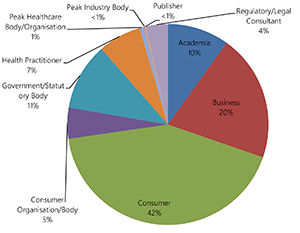
When we receive a complaint, it is recorded as a 'lead' within the AMS. Each lead is then assessed to determine the responsible parties involved and a case is then created for each party. The complaints received generated 2,436 cases. Of these, 1,601 cases were completed during the reporting period.
The following information is about these completed cases.
How the TGA handles cases
Cases are handled in accordance with the TGA's advertising complaints handling policy.
Like other regulators, we take a risk-based approach to complaints and case handling. This means that:
- we give priority to cases where the risk to consumers posed by a product, or the way in which a product is being advertised, is high, and
- our regulatory response is commensurate with the risk posed by the non-compliant advertising.
Each complaint we receive is triaged and cases are categorised as critical, high, medium or low, based on the risk to public health and safety. A summary of the criteria we use to categorise complaints, and the number of cases in each category for 2018-19, is shown in Figure 2.

Performance against key performance indicators
Table 1 below sets out the number of cases that were completed within our key performance indicators (KPIs).
The time to action a complaint (time-to-action) is the period of time commencing from when a complaint is received, including categorisation, and ending on initial engagement with the advertiser. The time taken to close a case (time-to-close) means the period of time from when a complaint was received, categorised and progressed as a case, to when no further action is required, and the case is completed. The target period of time that will apply for the TGA to action or close a complaint will depend on the priority categorisation of the complaint.
Further information about our KPIs can be found in Measuring our performance.
| Jul 2018 - Jun 2019 | |
|---|---|
| Prioritisation category | |
| Low | |
| Total completed cases | 1,480 |
| Time to action (target 95% in 14 days) | 1,214 (82%) |
| Time to close (target 90% in 20 Days) | 1,436 (97%) |
| Medium | |
| Total completed cases | 111 |
| Time to action (target 95% in 40 days) | 51 (46%) |
| Time to close (target 90% in 90 Days) | 17 (15%) |
| High | |
| Total completed cases | 2 |
| Time to action (target 95% in 20 days) | 2 (100%) |
| Time to close (target 90% in 90 Days) | 2 (100%) |
| Critical | |
| Total completed cases | 8 |
| Time to action (target 100% in 10 days) | 7 (87.5%) |
| Time to close (target 90% in 60 Days) | 7 (87.5%) |
While we have met some of the KPIs in time to action for high cases and time to close for low and high cases, this has not been the case for the medium and critical cases. As a higher than anticipated number of complaints has been received during this period, the TGA has prioritised resourcing to focus on the high and critical cases and this has resulted in delays in commencing investigations and taking actions for a large number of the medium cases. With respect to the single critical case that did not meet the time to action and time to close target time frame, this was due to changing of the categorisation of the case from medium to critical on further review, resulting in missing the target timeframe set for the critical category.
During this reporting period, the TGA successfully obtained orders from the Federal Court of Australia awarding $10 million in civil penalties against Peptide Clinics Pty Ltd (see illegal peptides). This addressed ongoing advertising non-compliance in a high priority case, in an area (performance and image enhancement) which has been a focus of recent TGA compliance activity. The large penalties awarded are likely to assist in deterring non-compliance by other advertisers in the industry.
These statistics will also be reported in the TGA's Annual Performance Statistics report, to be released later in 2019.
Most common breaches
Cases categorised as being medium, high or critical risk are investigated for compliance with the therapeutic goods advertising legislation—specifically, the Act and the Code.
Number of products represented across closed compliance cases
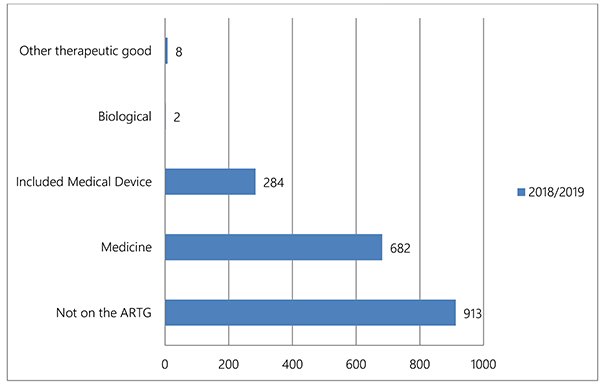
The 'Not on the ARTG' category mainly represents cases about the alleged advertising of illegal therapeutic goods - i.e. those therapeutic goods that are not included in the ARTG. However, this also includes some goods that are exempt from the requirement to be included e.g. homeopathic preparations. Exempt therapeutic goods are also captured under the medicine (e.g. homeopathic preparations) or medical device category (as relevant).
The Other Therapeutic Goods category includes disinfectants, tampons and menstrual cups.
The TGA is refining the granularity of the categories used which will improve the transparency of product categorisation in future.
A case may have more than one product recorded for it. Each product is assigned to a product category. The total of all categories therefore exceeds the total number of cases completed.
Breaches of the Therapeutic Goods Act 1989
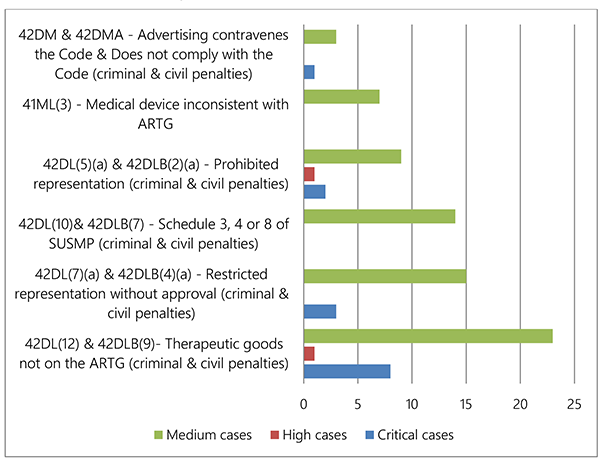
The most common contravention of the Act shown in Figure 4 is section 42DL(12), which applies to advertisements for therapeutic goods that are not entered in the ARTG but are required to be.
Note that a case may have more than one breach recorded for it. For example, a case may relate to breaches of several provisions of the Act. The total of all breaches will then exceed the total number of cases completed or the total of all risk categories will exceed the total number of cases completed for that risk category.
More detailed descriptions of the Act provisions are set out in Appendix 1.
Breaches of the Therapeutic Goods Advertising Code 2015
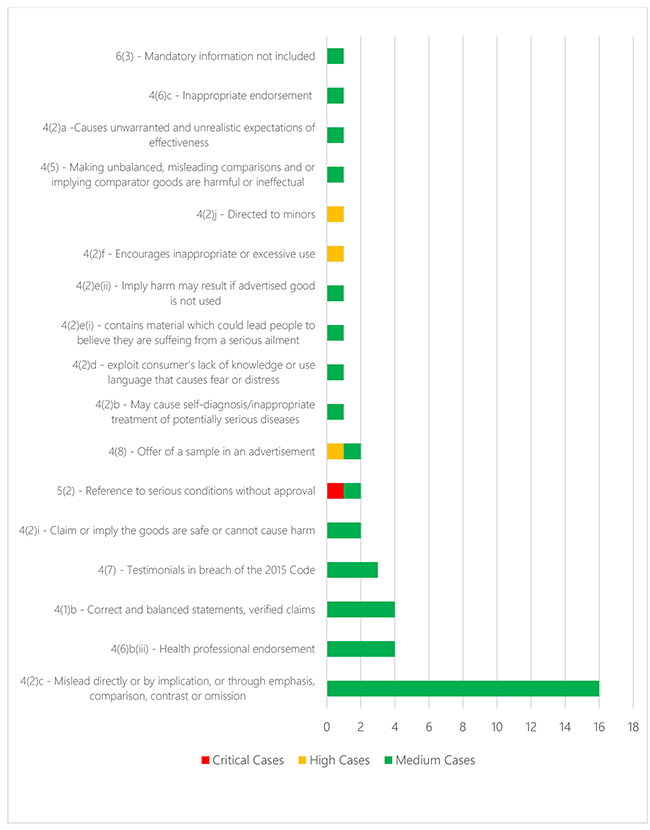
Breaches of the Therapeutic Goods Advertising Code (No.2) 2018
As the 2018 Code only came into effect on 1 January 2019 we have not yet completed a sufficient number of cases to reliably inform trends in breaches in relation to these new provisions - especially those cases that are dependent upon evaluation of scientific or clinical evidence to establish whether the advertising at the centre of the complaints was unsubstantiated or misleading. Only two cases were completed where there were breaches of the 2018 Code. Both these cases were medium-risk categorisation with collective Code breaches of sections:
- 9(a) - claims are truthful, balanced and not misleading,
- 9(b) - advertising is valid, accurate and substantiated,
- 10(d)(iv) - advertising must not imply harm may result if the good is not used,
- 15(2)(b) - scientific or clinical misrepresentation, and
- 15(3)(b) - citation required to scientific or clinical literature.
Number of cases in top 10 complaints categories
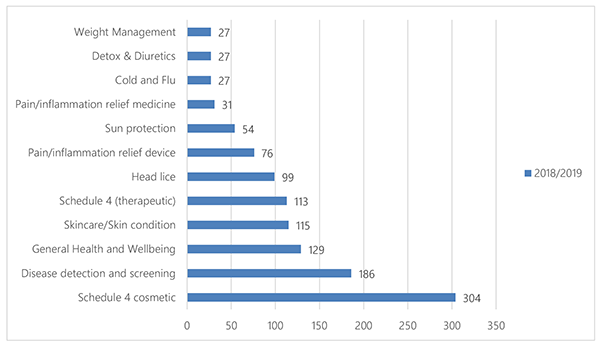
Figure 6 sets out the number of cases in each of the top ten complaint categories, as assessed across all product categories. Similar information for individual categories (medicines, included medical devices etc.) is in Figures 7-9. The Schedule 4 cosmetic category captures advertising to the public for prescription medicines used for cosmetic procedures (such as wrinkle reduction and filling). The products concerned include botulinum toxins, hyaluronic acid, and polycaprolactone. With the exception of botulinum toxins, these products are generally regulated as medical devices. The Schedule 4 (therapeutic) category refers to advertisements to the public for prescription medicines that are not being promoted for cosmetic purposes.
The disease detection and screening category consists largely of cases about the advertising of a range of different medical devices for this purpose, including bioresonance and live blood analysis devices.
The General Health and Wellbeing category represents advertising for the use or supply of therapeutic goods for the maintenance of health and not for the treatment or symptomatic relief of a health condition. The cases captured in this category generally relate to the advertising of medicines.
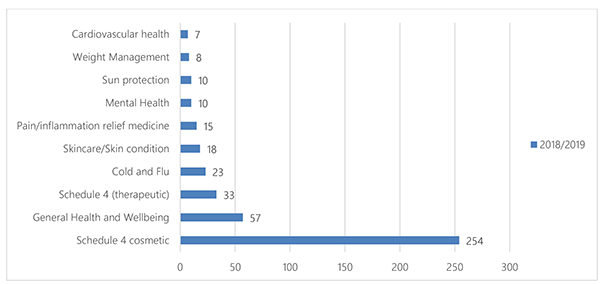
Despite the bulk of goods included in 'Schedule 4 cosmetics' being classed as devices, botulinum toxin (a medicine) continues to generate a large proportion of the cases in the Schedule 4 cosmetic category.
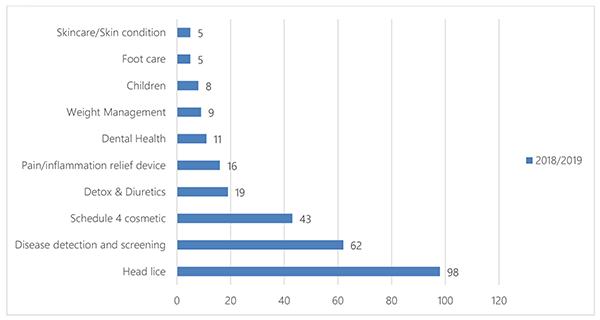
The head lice treatment class of devices includes those for both physical removal (such as combs) and goods that smother the lice (such as those containing essential oils). The majority of cases in the dental health category relate to the advertising of "invisible" orthodontic appliances followed by cases about dental impression materials.
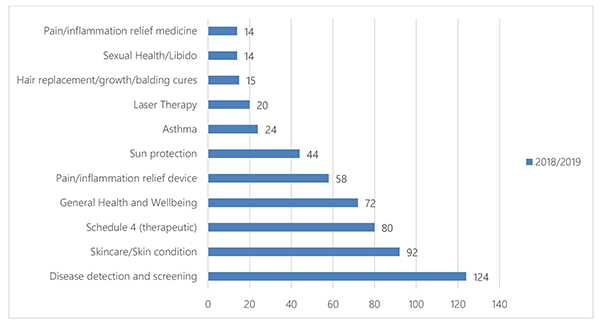
The Schedule 4 cosmetic class includes procedural devices for a range of face and body enhancement and modification procedures. Skincare and skin conditioning devices include thermogenic RF and laser, physically abrasive and suction devices for skin rejuvenation and resurfacing. 'Schedule 4 (therapeutic)' in this context includes illegal advertising of compounded prescription medicines and promotion of unregistered prescription medicines for athletic and body enhancement.
Completed compliance cases by action taken
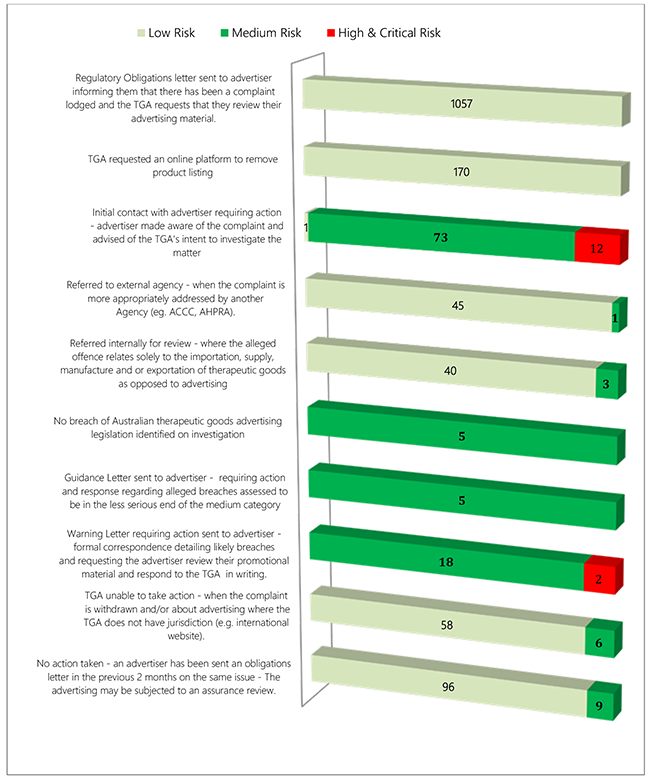
Please also refer to the section of this report 'Compliance and enforcement activities' for further information on higher level compliance actions.



